 |
 |
 |
| |
Randomized Comparison in Treatment-naive Patients of Once-daily vs Twice-daily Lopinavir/ritonavir-based ART and Comparison of Once-daily Self-administered vs Directly Observed Therapy
|
| |
| |
Reported by Jules Levin
CROI, Feb 2007
D Mildvan1, C Tierney2, Robert Gross*3, A Andrade4, C Lalama2, S Eshleman4, T Flanigan5, J Santana6, M Dehlinger7, C Flexner4, and the ACTG A5073 Study Team
1Beth Israel Med Ctr, New York, NY, US; 2Harvard Sch of Publ Hlth, Boston, MA, US; 3Univ of Pennsylvania Sch of Med, Philadephia, US; 4Johns Hopkins Univ Med Inst, Baltimore, MD, US; 5The Miriam Hosp, Providence, RI, US; 6Univ of Puerto Rico Sch of Med, San Juan; and 7Div of AIDS, NIAID, NIH, Bethesda, MD, US
Background: Potential advantages of directly observed therapy (DOT) in non-HIV settings and of simplified ART dosing in HIV justify studying these approaches in patients initiating ART.
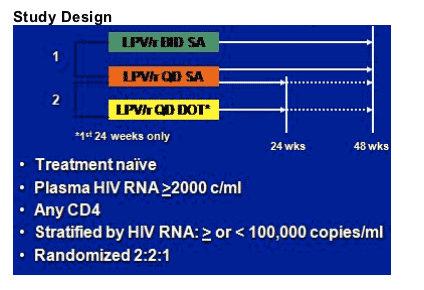
Methods: A5073 was a multicenter 3-arm open-label 48-week trial that randomized ART-naive patients with HIV-1 RNA ≥2000 copie/mL and stratified by screening RNA
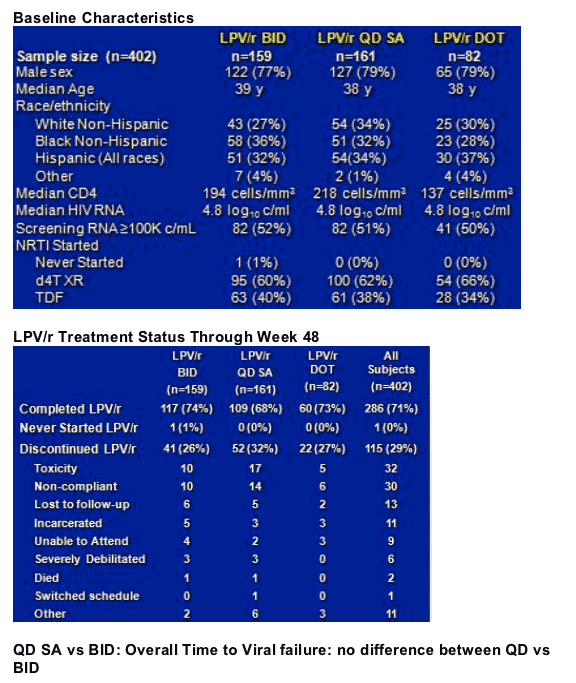
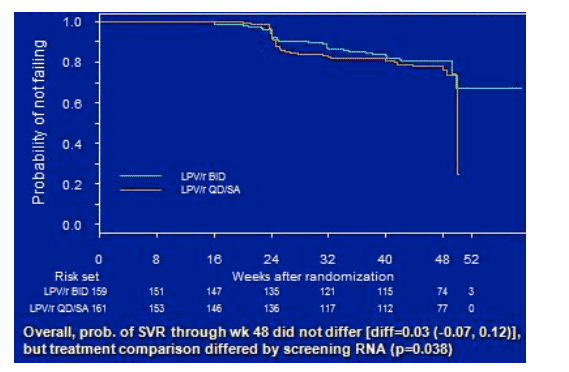
Time to Viral failure, by Stratum: screening HIV <100,000 or >100,000: there was no difference in viral response when VL was <100,000 but when baseline VL was >100,000 BID was significantly more successful than QD in achieving <200 copies/ml (undetectable)the probability of
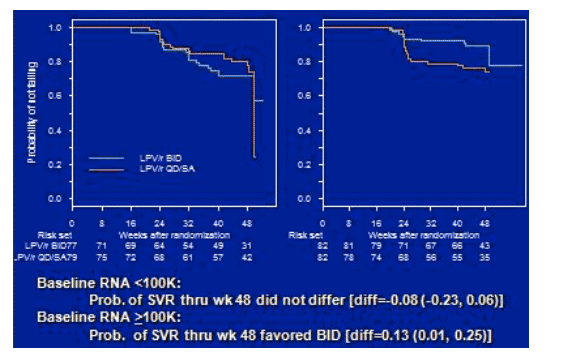
Results: We enrolled 402 patients at 24 sites who were 78% male, 34% Hispanic, 33% black non-Hispanic; 62% initiated d4T XR; median baseline CD4 count was 197 cells/mm3 and HIV-1 RNA was 4.8 log10 copies/mL. Of the total, 82% of patients completed the study, and 71% remained on initial LPV/r dose schedule. Overall, the probability of sustained virologic response through week 48 did not differ significantly between twice daily and once daily self-administered (difference 0.03; 95%CI –0.07, 0.12); however, the difference depended on the HIV RNA stratum (p = 0.038, pre-specified analysis). In the higher HIV RNA stratum, the probability (95% CI) of sustained virologic response through week 48 was significantly higher in the twice daily arm with 0.89 (0.79, 0.94) vs 0.76 (0.64, 0.84) in the once daily self-administered arm for a difference of 0.13 (0.01, 0.25). In the lower stratum, the probabilities were 0.72 (0.59, 0.81) and 0.80 (0.69, 0.88) for twice daily and once daily self-administered for a difference of –0.08 (–0.23, 0.06). Median DOT visit compliance was 86%. The probability of sustained virologic response through week 24 was higher for DOT (0.91: 0.81, 0.95) than once daily self-administered (0.84: 0.77, 0.89), but the difference of 0.07 (lower 95%CI: –0.01) was not significantly larger than 0.075 (p = 0.56). The probability of sustained virologic response through week 48 was not significantly different between DOT (0.72: 0.61, 0.81) and once daily self-administered (0.78: 0.70, 0.84) for a difference of –0.06 (–0.18, 0.07), 2-sided p = 0.19. Any effect while on DOT (by week 24) was lost after being off DOT (by week 48).
Time to New AIDS Diagnosis or Death
DOT Outperformed Self-Administered Therapy in Terms of New AIDS Diagnosis or Death with low hazard ratio of 0.29 (0.07, 1.29), but there were a relatively small number of events (13 in SA vs 2 in DOT) & it crossed 1 (I think he means CI)
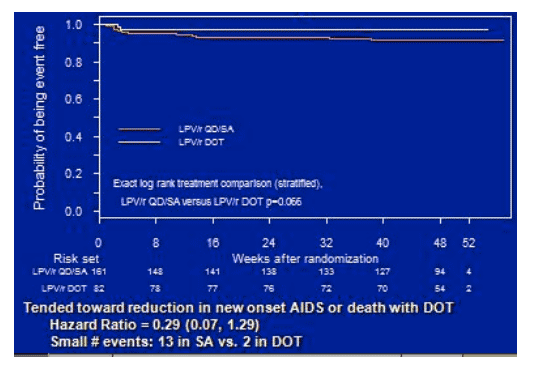
No significant difference between arms in:
--CD4 change
--time to grade 3-4 grade toxicity
They concluded that DOT was acceptable as a treatment modality: 74% of subjects completed 24 weeks of DOT; median DOT visit compliance was 86%; subjects had an improved view of burden of DOT as 49% had an improved view after completion vs 13% who found it more burdensome (p=0.004).
Conclusions: Although overall there was no difference in sustained virologic response between twice daily and once daily LPV/r, twice daily may have an advantage for ART-naive patients with high viral loads. But they said the mechanism needs evaluation, perthaps adherence or PK influenced response for individuals with >100,000. (note from Jules Levin: they did not report the % of patients receiving d4T vs TDF in >100,000 group, perhaps this affected outcome). DOT may have a treatment role while maintained, but there is no evidence of sustained virologic benefit once stopped. They suggested perhaps DOT would be beneficial for patients with adherence problems, so they’re designing such a study in Africa.
|
| |
|
 |
 |
|
|